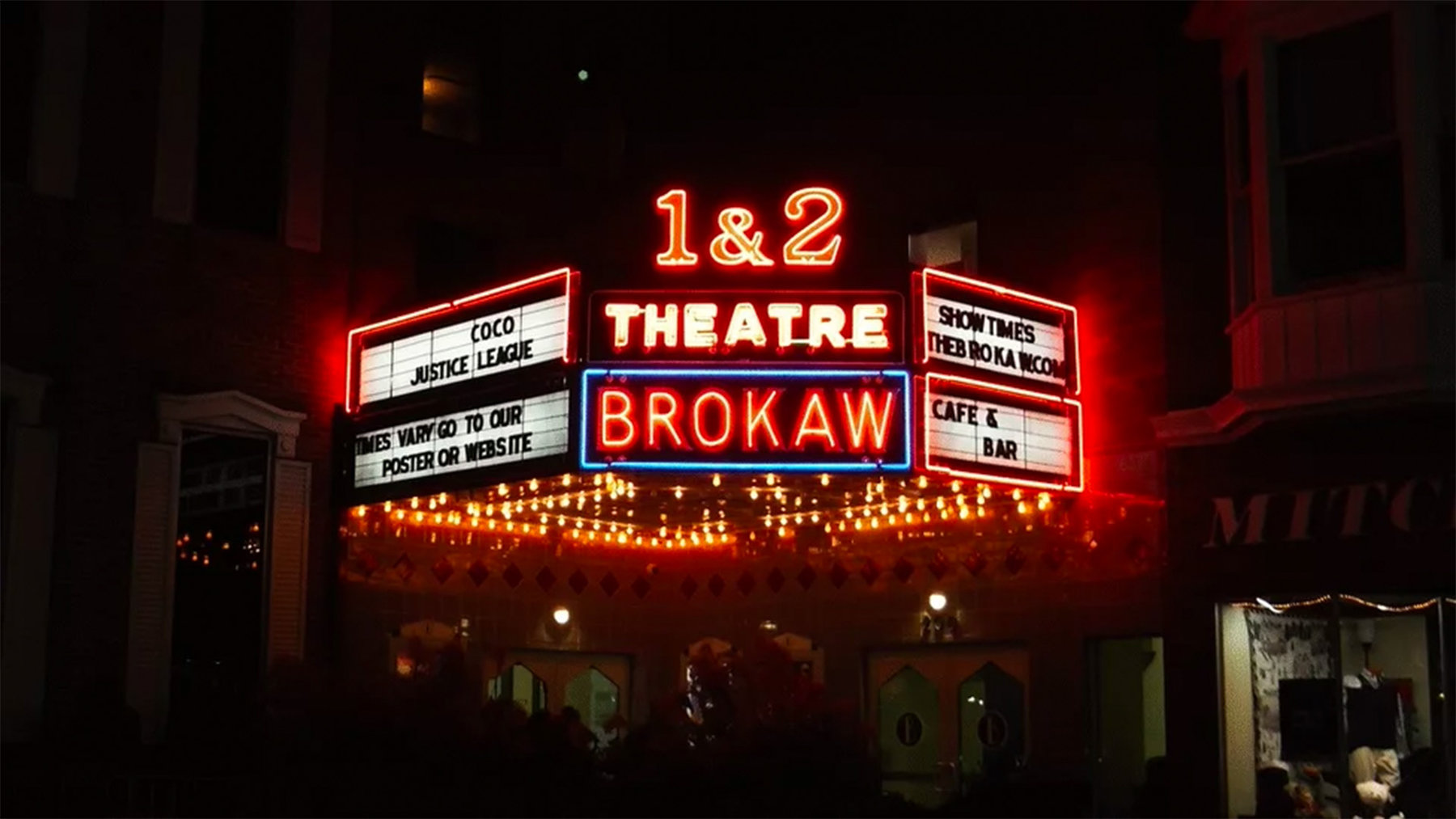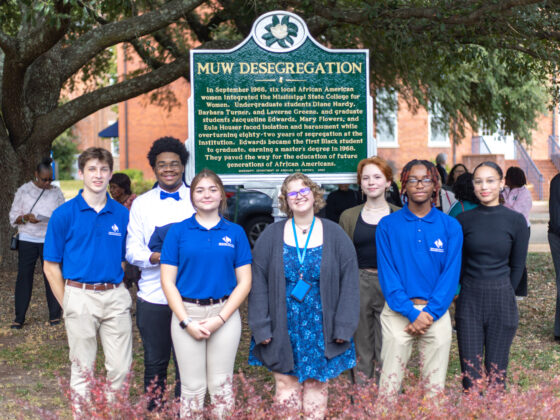Last month we traveled by car through several cities in Indiana, in a project organized jointly by New America Indianapolis, where our main partner was Molly Martin, and Indiana Humanities, as part of their new two-year-long INseparable program intended to foster conversations across the usual partisan divides. There we worked mainly with the IH director Keira Amstutz and the community-engagement director Leah Nahmias.
New America–Indy’s work is largely related to the economic and civic effects of rapid technological change—and how the state’s communities and economy can best prepare themselves for the next, inevitable disruptions. (Why do that in Indiana? As pointed out in the previous installment, it’s because the state is consistently at or near the top of rankings of manufacturing as a share of employment. Thus it’s very heavily exposed to trends good and bad in automation, offshoring, and other industrial shifts.)
Indiana Humanities’ programs include efforts to rebuild the structures of discussion, civility, and citizenship within the state. (And why do that in Indiana? Few states illustrate more clearly the coexistence of city-by-city progressive trends, notably in Indianapolis, Gary, Fort Wayne, South Bend, and elsewhere, and a statewide politics more and more closely aligned with conservative national movements. In contemporary shorthand: This is the state of Mayors Pete Buttigieg and Karen Freeman-Wilson, and of former Governor Mike Pence.)
Together these two groups suggested a series of stops along Indiana’s I-69 corridor—the “vein of gold,” as one local enthusiast put it, because of the manufacturing centers along this route. These first few installments of our new Our Towns series will involve brief overview sketches of three of these cities, highlighting three of the trends we’ve seen more generally in smaller communities that are discovering new paths forward.
Those three places along I-69 are Angola, Fort Wayne, and Muncie. Let’s start with the picturesque small town of Angola.

Downtown Angola, Indiana, during a summertime festival (Courtesy of Steuben County Tourism Bureau)
Angola is in the far northeastern corner of Indiana. If you keep going a few miles farther north along I-69, you’ll be in southern Michigan. If you head a few miles east, on U.S. Highway 20, you’ll be in northern Ohio. It’s the county seat of Steuben County; it was founded a generation before the Civil War, in 1838; and although it’s not close to any of the Great Lakes, it has long had a Midwest resort-town identity, because of a nearby state park and numerous local small lakes.
It has a population of about 8,500 people and a classic-look American downtown, whose central feature is a tall, slender column, topped by a large statue of Columbia and honoring those from Steuben County who fought in the Civil War. Some 1,300 local people served in the Union forces; nearly 300 of them died.
Why the name, Angola? The city’s histories say it was named after the city of Angola, New York, in the Buffalo area—which in turn was reportedly named to honor missionaries working in the Angola on the west coast of Africa, then a Portuguese colony. (The most frequently mentioned Angola, site of the state prison in Louisiana, has no direct connection to this Angola in Indiana. Prison histories say it was named for a nearby pre–Civil War plantation, which in turn was known as Angola because that is where some of the enslaved people in the area had been taken from.)
For us, the familiar parts of Angola were ingredients in the civic-renewal mix we’d seen in other towns of this size that were trying to maintain a viable economic and civic life. These included:
- The downtown itself, as the object of deliberate revitalization and beautification efforts. The downtown square features the Brokaw Movie House, built in the 1930s and now modernized with two screens and the contemporary luxury moviegoing experience. For instance, in addition to food, beers from two local craft breweries are on tap, along with spirits from the only local distillery in this part of the state.“Ten years ago, when we started this downtown-renewal push, there were eight or 10 vacant buildings downtown,” Angola’s mayor, Richard Hickman, told us. “Now there are only three.” Hickman, who came to town for a job with an insurance firm in the 1970s and has been mayor since 2001, said that in the past few years, the number of people choosing to live downtown had gone from just a handful to “about 30 apartments on the second or third floor of downtown buildings, with more going in.” As we’ve seen in many other places, the tipping point in downtown revitalization often occurs when people choose to rent or buy living spaces downtown. Who’s making this move in Angola, we asked Hickman? “A lot are younger people, some are older people”; others, he said, are people originally from the area who have relatives nearby and want to keep a local base.
- An arts-related strategy, to make the city attractive both to first-time visitors (who might decide to return) and to people who grew up in the region, moved away, but still consider coming back someday.Both elements of this equation—finding some way to place a small town on the mental map of people who had never previously known of it, and increasing its allure to those already familiar but wondering whether they could actually return—are parts of the small-town tool kit we’ve seen applied from Maine to Oregon to Mississippi. Festivals, sporting and recreational facilities, arts projects, and anything else that makes a place distinctive are important parts of this mix. Angola tries to keep up a busy calendar of events. One example: Last year Indiana Humanities sponsored Frankfenfest, a statewide one-state, one-story to have people in Indiana all read and discuss Frankenstein on the 200th anniversary of the book. Angola went all out for the project, as a professor at a local university described.
- A diversified advanced-manufacturing economy, of smaller and medium-scale firms (rather than the giant factories of yore). In keeping with the manufacturing-centrism of the state as a whole, the region is dotted with factories that employ tens or dozens of workers. They’re mainly in the broader supply chain of the auto industry, machine tools, specialty metals, and health and medical supplies. Vestil Manufacturing employs several hundred people in its factory not far from downtown. (Elkhart, Indiana, the longtime center of RV manufacturing, is 50 miles to the west. Warsaw, Indiana, the historic center of prosthetic and orthopedic-gear production, is just a little farther away, to the southwest.)
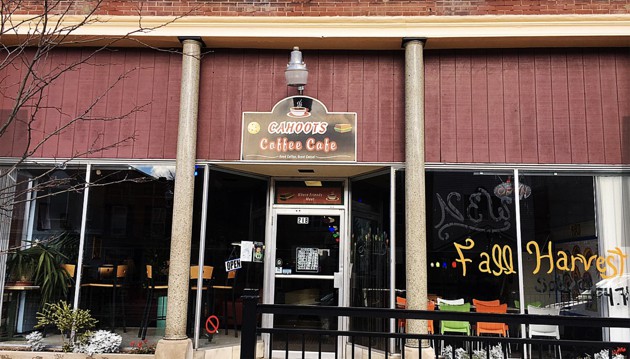
- A realistic awareness of local problems, exemplified by the nonprofit downtown coffee shop Cahoots, designed both as an attraction for ordinary diners and visitors and as an activity site and haven for young people who are homeless or otherwise troubled. “Our mission is to provide a safe place, and mentoring, and just food for the young of our community, and beyond,” Richard “Rock” Campbell, of Cahoots, told me. “We have lots of kids who are passing through, out on their own. We make sure at least they get something to eat.”
This past bitter winter meant an unusually high number of snow-closure days for the public schools. “We decided to offer lunch for kids on those days, when they weren’t getting fed at school,” Campbell told me. Several dozen students would show up. (Cahoots was originally sponsored by local churches and now operates as a 501(c)(3) charity.)
Those are traits we might have anticipated in Angola. The surprise was the scale and importance of the local university, Trine, a school known for engineering that is its own institutional-renewal story and plays a significant role in the future of the town.
For more than 120 years, Trine was known as Tri-State. At its founding in the 1880s it was Tri-State Normal College, the name reflecting its placement on Indiana’s border with Michigan and Ohio. By the 1970s it had become Tri-State University, and then in 2008 it took on its current name, Trine University. The new name is not some linguistic play on Tri-State but refers to an alumnus and local industrialist named Ralph Trine and his wife, Sherri (the Trine family runs Vestil Manufacturing), and it was part of an ambitious recasting of the school.
Under Earl Brooks, originally from Tennessee, who has been president since he came to what was then Tri-State in 2000, the school has quadrupled its enrollment from about 1,300 to more than 5,000, has expanded its course offerings, and has invested more than $150 million in its facilities and programs. Trine is the single largest employer in Angola, with higher-than-average wages. It attracts students from around the United States and about 20 other countries (mainly India, China, Japan, and Saudi Arabia)—and in so doing gives these outsiders a reason to consider this corner of Indiana in their long-term plans. “This has an effect on the town,” Mayor Hickman told me. “It’s a little place in Indiana, but people are used to seeing new faces. They don’t give you funny looks or stop and ask why you’re here.” Steuben County’s role as a summer resort site has a similar opening-up effect, as visitors arrive mainly from other parts of the Midwest.
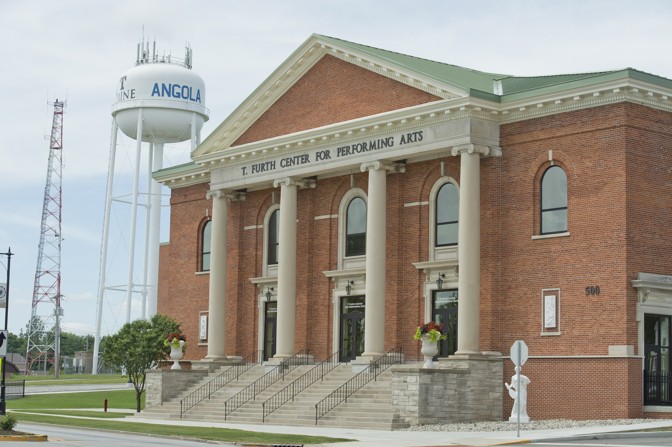
Trine has opened satellite campuses around the region. It refurbished a historic Angola church and turned it into a performing arts center. (The reincarnation of houses of worship that have lost their congregations, into new roles as civic or even commercial spaces is a trend we’ve seen in many other cities, and to which we’ll return.) Trine has opened an ice-hockey arena, which has also become a home for community teams. It’s working in partnership with the city on a new innovation zone and has already fostered a number of start-up tech and manufacturing companies in the region.
And meanwhile the school contends that, over the past five years, 99 percent of its graduates have been either employed or in a graduate program of their choosing, within six months of getting their degree from Trine. (I can’t verify any of this myself, but year by year the school’s alumni office makes such an announcement—for instance here in 2018. The school also claims that the average student debt at graduation is under $30,000.)
How can this be?? I asked Earl Brooks several times, in more and less polite forms, when talking with him in Angola and later by phone. It’s an era when most small, private, remotely located colleges and universities are struggling. Why Trine? Why now? Is this really true? How?
The answers from him and others involved 20 years’ worth of systematic and successful engagement of alumni, local business leaders, foundations, and other donors—plus Trine’s heightened identity as mainly an engineering school that can equip graduates with marketplace skills. “There are good things and bad things about a reputation as an engineering school,” Brooks told me, when we talked at Cahoots. “The good thing is the job-placement rate. The bad thing is people thinking you’re only about engineering.” Obviously Trine and Angola consider that for now the goods outweigh the bads.
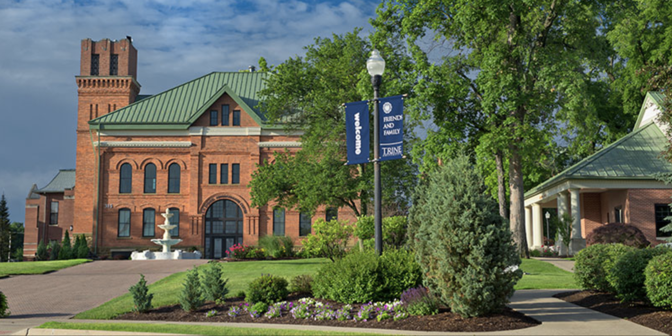 Trine University main campus (Courtesy of Trine University)
Trine University main campus (Courtesy of Trine University)As mentioned earlier, Deb and I believe in showing our homework. We don’t pretend to know either Trine or Angola in any depth. We’ll learn more; we’ll come across contradictions and complications; and we’ll do our best to render them honestly in connection with trends elsewhere.
But as a start to this new journey, the point for the moment is: More was going on in a small part of Steuben County, and a small but fast-growing university there, than the national discourse about small towns, the Midwest, and interior America would normally recognize.

